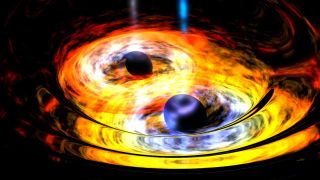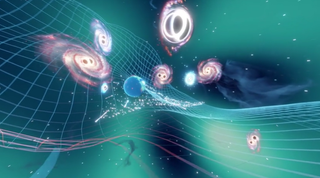Mainly most likely essentially the most detailed map of the universe ever created utilizing gravitational waves would possibly reveal hidden black holes, merging supermassive black holes and even the large-scale improvement of the cosmos.
The evaluation, carried out by a bunch led by astronomers from Swinburne School of Expertise, furthermore launched the largest-ever galactic-scale detector of gravitational waves, which is perhaps primarily ripples in spacetime.
This analysis has supplied additional proof of a background “hum” of gravitational waves that permeates the universe. As such, it would grant new insights into the universe’s earliest black holes, how they grew, and the affect that that they’d on the evolution of the comedian improvement.
“Finding out the [gravitational wave] background lets us tune into the echoes of cosmic occasions all by means of billions of years,” group member and Swinburne School researcher Matt Miles talked about in an announcement. “It reveals how galaxies, and the universe itself, have developed over time.”
The gravitational wave background that Miles refers to was created by merging supermassive black holes all through the early and distant universe. It was first revealed by a gravitational wave detector that faucets into quite a few quickly spinning neutron stars, or “pulsars,” and a exact time-keeping instrument often known as a pulsar timing array as a part of the NANOGrav enterprise.
This new evaluation furthermore relied on a pulsar timing array, although with assist from the MeerKAT radio telescope in South Africa. By enhancing detection strategies, the nanosecond precision of the MeerKAT Pulsar Timing Array granted the Swinburne-led group a stronger sign than before.
“What we’re seeing hints at a much more dynamic and energetic universe than we anticipated,” Miles talked about. “Everybody is aware of supermassive black holes can be found in the marketplace merging, nonetheless now we’re beginning to ask: the place are they, and what number of can be found in the marketplace?”
Gravitational wave map delivers suprises
Gravitational waves have been initially predicted by Albert Einstein’s in his considered gravity, often known as “common relativity.” The good physicist’s magnum opus thought states that objects with mass set off the very materials of house and time (united as a four-dimensional entity often known as “spacetime”) to “warp.” It’s from such warping that gravity arises.
Nonetheless, Einstein furthermore predicted that when large objects velocity up, they set off ripples that unfold by way of spacetime on the tempo of sunshine. These are generally known as gravitational waves.
An event of gravitational wave-emitting methods are binary black holes, which set spacetime ringing as two black holes inside every of those methods swirl spherical each other. As gravitational waves surge away from the binary black holes, they carry with them angular momentum. This vitality loss causes the black holes to attract collectively and emit gravitational waves sooner and sooner — that’s, till the gravity of those cosmic titans takes over, and so they additionally collide and merge.
This extraordinarily environment friendly occasion objects spacetime ringing with a high-pitched “scream” of gravitational waves.
Black gap mergers are important to understanding the evolution of the cosmos. That is how the supermassive black holes with masses equal to a complete bunch of tons of, and even billions, of suns that sit on the hearts of giant galaxies are born.

Pulsars shall be utilized to detect gravitational waves due to they will spin as lots as 700 occasions per second; furthermore they blast out beams of radiation that sweep the cosmos just like the illumination of a cosmic lighthouse.
The important issue, although, is {{{that a}}} pulsar’s spin timing is awfully widespread, that suggests that when an unlimited group of pulsars is taken into consideration en masse, they’re typically utilized as a exact cosmic clock — a clock delicate ample to detect tiny fluctuations in spacetime attributable to the passage of gravitational waves.
That is how the MeerKAT Pulsar Timing Array allowed the group to create a terribly detailed gravitational wave map — and that spacetime-ripple-forged cosmic atlas truly revealed a shock attribute.

The researchers found an sudden anomaly of their map: a “hotspot” that seems to exhibit a “directional bias” for gravitational waves.
Beforehand, researchers had assumed that the universe’s gravitational wave background would haven’t any hottest path and thus be evenly unfold all by means of the sky.
“The presence of a hotspot would possibly counsel a specific gravitational wave present, equal to a pair of black holes billions of occasions the mass of our photograph voltaic,” talked about group member and Monash School researcher Rowina Nathan. “Trying on the development and patterns of gravitational waves reveals us how our universe exists presently and incorporates indicators from strategy once more to the Big Bang.
“There’s additional work to do to hunt out out the importance of the hotspot we discovered, nonetheless this an thrilling step ahead for our subject.”
The group’s findings have opened the door to new, unpredicted discoveries regarding the improvement of the universe.
These discoveries would possibly correctly be delivered by the galactic-sized gravitational wave detector shaped by the MeerKAT Pulsar Timing Array, which can now proceed to refine its gravitational wave map.
“By trying to find variations all through the gravitational wave sign all by means of the sky, we’re on the lookout for the fingerprints of the astrophysical processes shaping our universe,” Kathrin Grunthal , group member and a scientist on the Max Planck Institute for Radio Astronomy, talked about all through the assertion.
